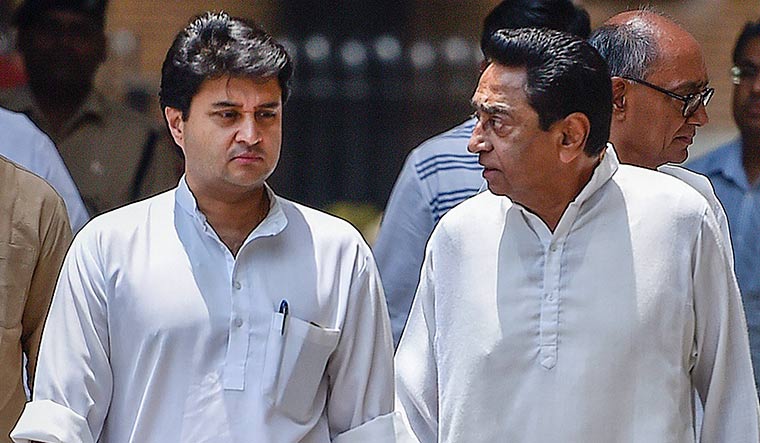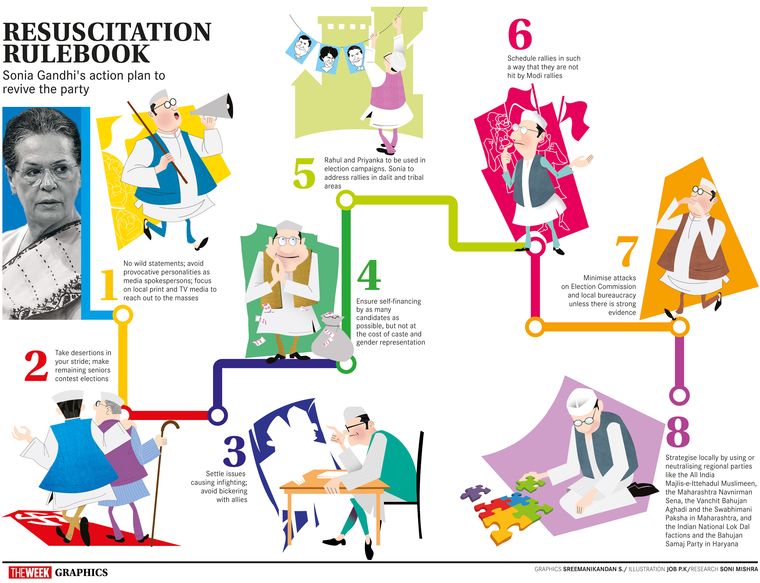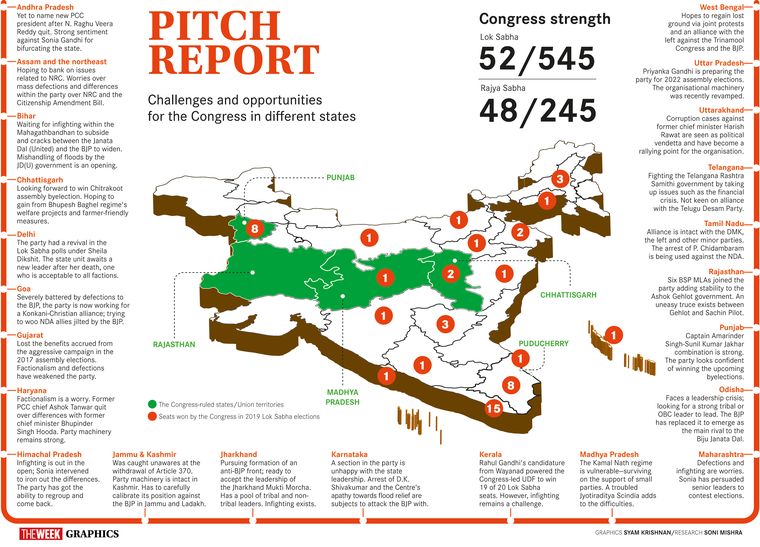Sonia Gandhi, taking her first steps in active politics, gave a four-word clarion call to a down-and-out Congress at a 1998 rally in Haryana’s Rohtak: “Get the right leadership”. Soon enough, the then 52-year-old Sonia ousted a listless Sitaram Kesri as Congress president.
Now, 21 years later, the Congress is yet again in the electoral doldrums and is mired in deep organisational crises. And Sonia, weary after two decades of leadership, has the role of Congress president thrust upon her again.
In 1998, she had banged heads together to set the Haryana unit in order. And this August, as she took charge as party president, her first challenge was to resolve the leadership impasse in the Haryana Congress, which threatened to rip the state unit apart.
Through consensus-building, Sonia placated former chief minister Bhupinder Singh Hooda, who had allegedly been threatening to leave the party. However, she did not make him state party president. His long-time rival Kumari Selja replaced Ashok Tanwar, his bête noire, as state party president. The choice of Selja conveyed that Sonia was not giving in to Hooda’s arm-twisting.
As interim chief, Sonia will be in charge of three major areas—party organisation, parliamentary strategy and reaching out to other opposition parties.
She has turned her focus to the upcoming elections in Haryana, Maharashtra and Jharkhand, especially as a lot of time had been lost because of Rahul Gandhi’s insistence on stepping down as party president after the Lok Sabha elections debacle in May.
Since taking over, Sonia has focused on long-pending organisational changes in the state units, appointment of election committees, getting wayward colleagues back on track and making sure that the party at least has a semblance of an agenda for the assembly elections.
She held a series of meetings with leaders from election-bound states and laid down guidelines, which included rewarding loyalty in ticket distribution and focusing on local issues rather than falling into the BJP’s nationalism trap.
“Three states are going for elections, and changes have been made,” said Selja. “Earlier, we worked with Sonia ji. Then we worked with Rahul ji. We are again working with Sonia ji. For us, it is all right. We have to do our job.”
If in Haryana Sonia rejigged the party to try and end the battle within, in Jharkhand, where factionalism resulted in workers coming to blows, she gave the charge of leading the state unit to IPS officer-turned-politician Rameshwar Oraon. To maintain balance, she also appointed five working presidents.
It was decided that the party would try to cash in on any anti-incumbency against the BJP governments; the state units have been told not to focus on the BJP’s central agenda of Article 370 and the National Register of Citizens.
Reportedly, Sonia also told off state units for not exposing any big corruption cases of the BJP regimes and for not having a powerful line of attack against them.
“The BJP projected the face of Narendra Modi in the Lok Sabha elections,” said Oraon. “People know that Modi will not be chief minister. In the assembly polls, the focus will be on the performance of Chief Minister Raghubar Das.”
In Maharashtra, where there has been heavy bleeding of senior talent, experienced leaders such as Prithviraj Chavan, Ashok Chavan and Balasaheb Thorat have been asked to contest. Similarly in Haryana, the party rests on the influence of Hooda, a tall Jat leader. In Jharkhand, the party has fallen back on the experience of Oraon and veteran Subodh Kant Sahai.
“I agree that many leaders have left the Congress,” said Nana Patole, head of the Congress’s Maharashtra campaign committee. “But the workers and the people are with us. We will go into the elections with all our might. Senior leaders will lead from the front.”
Sonia has emphasised on having alliances in Maharashtra and Jharkhand. She has asked local leaders to involve regional allies and to avoid criticising them. She also reached out to Nationalist Congress Party president Sharad Pawar, seeking his guidance in crafting the Maharashtra campaign.
Alliances aside, Sonia has also told party men that, rather than generally ranting on hindutva or nationalism, they should raise specific issues. The party was quick to distance itself from senior leader Digvijaya Singh’s comment on “saffron-clad criminals” in the backdrop of the Chinmayanand case.
Sonia, reportedly, was livid with Jairam Ramesh and Shashi Tharoor for raking up a debate on whether Modi should be attacked or not. Sonia confidant A.K. Antony, who is chairman of the party’s disciplinary committee, pulled up Ramesh and Tharoor, telling them they had the party fora to express their views and could approach Sonia directly.
To keep a check on motormouths, it has been conveyed that only senior spokespersons will speak on issues, and Randeep Surjewala, who heads the party’s communications department, will take guidance from seniors.
However, Rahul and Priyanka Gandhi Vadra, who is Congress general secretary in charge of eastern Uttar Pradesh, are expected to continue butting heads with Modi.
Sonia also got Antony to deal with the generational clash in Madhya Pradesh and Rajasthan, and the results are visible. There are fewer attacks by Jyotiraditya Scindia against Chief Minister Kamal Nath in Madhya Pradesh, and Deputy Chief Minister Sachin Pilot against Chief Minister Ashok Gehlot in Rajasthan. While the government in Rajasthan is stable now, the Madhya Pradesh government is technically a minority one and could be toppled.
Sonia has also asked Congress-ruled states to have greater coordination between the government and the organisation and focus on implementing manifesto promises. Apparently, at a meeting with Congress chief ministers, Gehlot and Kamal Nath listed the achievements of their governments. Sonia asked them why, if they had done a good job, had the party had done so poorly in their states in the Lok Sabha elections.
Sonia has also exhorted leaders and workers to hit the streets on the issue of economic slowdown. Realising that the party has lost its grassroots connect, she has approved a plan to reach out to the people, which includes a membership drive and a training programme for workers.
However, Sonia is not expected to have it easy. Her return at the helm has caused a realignment of dynamics between the old guard and the young leaders, making the youth brigade restive. Leaders like Ashok Tanwar and former Mumbai Congress president Sanjay Nirupam have openly said that senior leaders were out to eliminate Team Rahul. The peace bought in the warring state units has been extremely fragile, and the infighting and dissent have become more difficult to control.
The seniors yet again have the upper hand. Hooda’s success in getting Tanwar replaced is being seen through the prism of his closeness with old guard leaders like Ahmed Patel and Ghulam Nabi Azad. The Data Analytics Department, which Rahul created, has been reduced to a cell under the organisation department.
The schism between the old and the young was visible at a meeting where the new training module for party workers was discussed. Rahul protege Sachin Rao, who heads the party’s training department, proposed that the trainers be called preraks. The old guard rejected the idea, saying it was similar to the Rashtriya Swayamsevak Sangh’s pracharaks, and Sonia agreed. The trainers will simply be called coordinators.
Ahmed Patel, who was on the sidelines in the Rahul regime, is again pre-eminent. Sonia’s key advisers, including senior leaders such as Manmohan Singh, Antony and Azad, have an important role in devising party strategy. K.C. Venugopal, identified as a Team Rahul member, continues to be in charge of organisation, but he is no longer the inevitable member of all committees. Venugopal, however, briefs Sonia regularly on state units and departments.
In Congress-ruled Rajasthan, there is buzz that Gehlot is thinking of appointing two more deputy chief ministers, one each from the dalit and Jat communities. The reported plan is meant to balance caste representation in the top rung of the government. However, it is being seen as a move to downsize Pilot by removing the exclusivity of the post.
“The young generation expressing itself is something that has happened in the past, too,” said Venugopal. “But the party has a good balancing system to give weightage to the senior leaders and opportunity to the young leaders.”
Even if superficially, an effort has been made to convey that the current set-up is not anti-Rahul. In party meetings, seniors still talk highly of Rahul’s strategy for the elections in Karnataka, Madhya Pradesh, Chhattisgarh and Rajasthan. It is said that barring the Lok Sabha elections, Rahul was a successful president. The generational divide, however, threatens to only get deeper.
The frustration of young leaders is palpable, with Milind Deora and Jitin Prasada appearing to speak in favour of Modi’s policies. The resignations by Jharkhand Congress president Ajoy Kumar and Tripura Congress president Pradyot Deb Burman have been attributed to their difficulties in working with senior leaders.
In Haryana, the clash of generations has wrecked the compromise worked out by Sonia. The young Tanwar, who resigned from the party on October 5, held a massive agitation in front of Sonia’s residence to protest the “irregularities” in selection of candidates. He also levelled serious allegations against the veteran Hooda, saying tickets were sold. “In the past few years, numerous conspiracies have been hatched to eliminate young leaders groomed by Rahul Gandhi,” said his resignation letter. “Unfortunately, most victims of this conspiracy may not have the courage to stand up.”
He also targeted some of the seniors, saying, “Haryana’s former general secretary in-charge Kamal Nath’s attitude was that of not caring about Haryana, but Azad’s attitude is that of playing the game and playing it dirty.”
The situation was similar in Maharashtra, where former Mumbai Congress president Sanjay Nirupam indicated that he was on the verge of leaving the party. “All these people sitting in Delhi, who are working with Sonia ji, are biased,” he said. “They have no understanding of issues, and they are only focusing on how to eliminate leaders like me.... And the same people who were conspiring against Rahul Gandhi are now running the party.”
Nirupam, aggrieved that his only recommendation for a ticket was rejected, hit out at party general secretary Mallikarjun Kharge, claiming tickets were given based on the whims of the seniors and not feedback or survey. The protests by Tanwar and Nirupam indicated that, contrary to Sonia’s directives, the process of giving tickets failed to remain above board.
Down south, there seems to be no end to the infighting in the Congress’s Karnataka unit after the fall of its government there. The party is split wide open, with a section of leaders criticising the style of functioning of former chief minister Siddaramaiah and state party president Dinesh Gundu Rao. The dissatisfaction has been conveyed to Venugopal, who is in charge of Karnataka.
“Indecision of the high command has [led to] problems in the states festering and turning into an organisational crisis,” said a senior Congress leader. “It will now be difficult for Sonia Gandhi to resolve these issues.”
Importantly, Sonia’s return has not ended the exodus of leaders from the party. The latest being Tanwar. Earlier, former Mumbai Congress president Kripashankar Singh jumped ship ahead of elections, just like several other leaders in Maharashtra. Nitesh Rane, son of former chief minister Narayan Rane, also quit to join the BJP in the poll-bound state.
Even in Sonia’s own constituency of Rae Bareli, dissent is brewing. Congress MLA Aditi Singh defied the party and attended a special assembly session called by the Yogi Adityanath government on Gandhi Jayanti. Aditi, against whom the Congress has issued a show cause notice, had earlier supported the Modi government’s move on Article 370. In fact, sources close to Aditi, who was brought into the Congress by Priyanka, say she could soon join the BJP.
“The Congress that Sonia inherited in the post-Narasimha Rao era was a better organised party with deeper roots in the various provinces,” said Abhay Kumar Dubey of the Centre for the Study of Developing Societies. “The Congress she heads now is much weaker, both organisationally and morally.”
No one is expecting miracles from Sonia; the focus is on merely putting the processes back on track. She has told senior leaders that the coming period would be difficult because of the ultra-nationalism the BJP and the RSS propagate. There is also a feeling that investigating agencies are harassing Congressmen with business interests. A senior leader said several of his colleagues who left the party confessed that they had only three options—suicide, jail or joining the BJP.
It is, however, felt that the attempts of the BJP-RSS combine to impose its singular view of India will backfire, as it happened when there was talk of making Hindi the national language or having NRC outside Assam. The Congress will then get more support, the party hopes.
There is also pressure on Sonia to campaign for the upcoming elections, but that would happen only if her health permits. Otherwise, the party might play her recorded messages through television ads and on social media.
The Congress is expected to begin discussions on electing a full-time president only after the Delhi state elections early next year. As no non-family member enjoys enough support within the party, there is a likelihood of a Gandhi becoming the full-time president. Even Rahul’s return is not ruled out.
“He will definitely come back to lead the party. Evidently, he needed time to introspect and perhaps plan out the next strategy,” said Punjab Chief Minister Amarinder Singh.
There is also speculation that Sonia could be keeping the seat warm for Priyanka. While Rahul has made it clear that he would not drive from the back seat, Priyanka reportedly provides her mother with inputs on strategy.
For now, though, Sonia’s focus is on getting the Congress up and running.
But, she must know that 2019 is not 1998.






